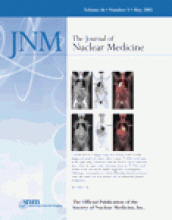TO THE EDITOR:
In a recent article (1), Watanabe et al. demonstrated radiation damage to lymphocytes in thyroid cancer patients after 131I therapy. The authors found that after administration of 3.7 GBq of 131I, the damage to B lymphocytes in vivo may be equivalent to the damage after a mean external-irradiation dose of 0.45 Gy in vitro. Watanabe et al. did not, however, directly compare their data with blood or bone marrow absorbed dose values for patients receiving radioiodine therapy. A possible explanation for this fact is that a standardized protocol for the determination of the absorbed dose to the blood or to the bone marrow does not exist for radioiodine treatments of differentiated thyroid cancer (DTC). Moreover, almost no data on the absorbed dose to the blood after radioiodine have been published.
In a recent international multicenter study (2), we established such a standardized protocol for determination of the blood dose after administration of radioiodine to patients with DTC. Using this protocol, it is possible to compare absorbed blood doses directly with the results of biologic dosimetry and to observe whether the different calibration methods caused dose-rate effects.
In this study (2), we assessed the absorbed blood dose to 9 patients with DTC who twice received a tracer dose of 74 MBq of 131I before ablation therapy. The activity concentrations in blood samples taken at 2, 6, 24, 48, and 120–144 h after administration of the 131I tracer were used to generate blood time-activity curves and to determine the cumulated radioactivity concentration in the blood. Whole-body γ-camera scans (“conjugate views”) were used to generate whole-body time-activity curves and to determine the cumulated radioactivity concentration in the remainder of the body. The blood dose was calculated as the sum of contributions from the cumulated radioactivity concentration in the blood, the residence time in the remnant, and the residence time determined for the remainder of the body, each weighted with adequate S values. In this approach, the residence time in the remainder of the body is defined as the whole-body residence time minus the residence time in the remnant and the residence time in the blood.
Blood dose values were calculated for vessel radii of 0.02 and 0.5 cm (3). For hypothyroid patients, the correspondent numbers are 0.09 ± 0.02 mGy/MBq (unpublished data, 2003) and 0.13 ± 0.03 mGy/MBq (2), respectively. If the kinetics of 74 MBq of 131I are postulated to be equal to those of 3.7 GBq of 131I, the expected blood dose range is between 0.32 ± 0.07 and 0.47 ± 0.10 Gy. The value of 0.45 Gy reported by Watanabe et al. (1) is well within this range.
Watanabe et al. (1) suspected that they underestimated the absorbed dose in radioiodine therapy because their calibration was based on high-dose-rate external-radiation exposure. After high-dose-rate irradiation, one would expect more pronounced biologic effects (4).
When the results of both dose assessment methods are compared, no difference in dose values is found within the margin of error. A dose-rate effect therefore is obviously not observed.
A multicenter ablation study of a large number of patients with DTC is under way. The results of that study, which includes blood dosimetry, will allow further comparison to the dose values given by Watanabe et al. (1).







